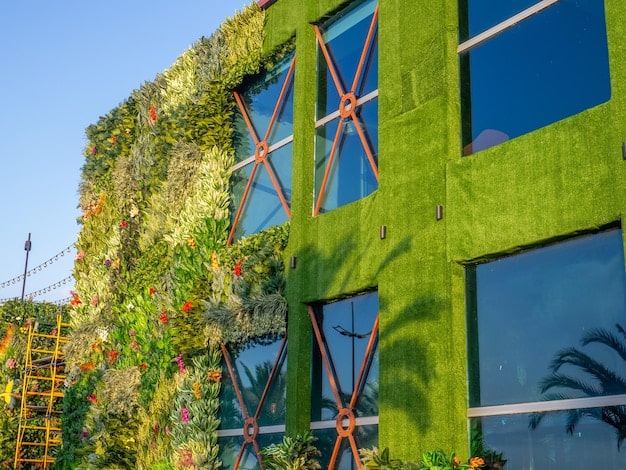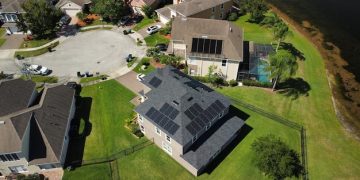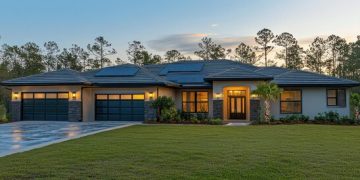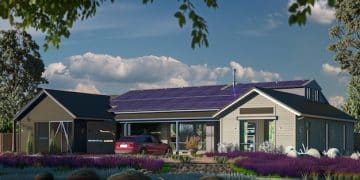Green Building Materials: Sustainable Homes in the US

Achieving truly sustainable construction in the US hinges on the widespread adoption of innovative green building materials, offering environmental benefits like reduced carbon footprints and energy efficiency, alongside long-term economic advantages for homeowners.
The concept of sustainable living has moved from niche interest to mainstream imperative, particularly in the construction sector. As awareness of climate change and resource depletion grows, the demand for eco-friendly alternatives is skyrocketing. This shift places Green Building Materials: Constructing Sustainable Homes in the US at the forefront of modern residential development. It’s no longer just about aesthetics or cost, but about creating structures that harmonize with our planet.
The Foundations of Green Building: Why Materials Matter
The environmental impact of conventional construction is substantial. From material extraction and manufacturing to transportation and disposal, each stage contributes to greenhouse gas emissions, waste generation, and natural resource depletion. Green building materials offer a vital alternative, reducing this ecological footprint significantly. They are selected for their low environmental impact throughout their lifecycle, from cradle to grave. This includes everything from their embodied energy—the total energy consumed in their production—to their recyclability at the end of a building’s life.
When we choose sustainable materials, we’re not just making a single, isolated decision; we’re initiating a cascade of positive effects. These materials often come from local sources, which minimizes transport emissions. Many are made from recycled content, diverting waste from landfills. Others are rapidly renewable, meaning they can be replenished quickly without depleting natural ecosystems. Furthermore, their use can improve indoor air quality, contributing to healthier living environments for residents. This holistic approach is what truly defines green building.
Reducing Environmental Footprint
Choosing materials that minimize the negative impact on our planet is paramount. This encompasses several key factors.
- Lower Embodied Energy: Materials like recycled steel or sustainably sourced timber require less energy to produce than traditional options such as concrete or virgin aluminum.
- Reduced Waste: Many green materials are designed for minimal waste during construction or can be recycled and reused after demolition.
- Sustainable Sourcing: Prioritizing materials from local, ethical, and renewable sources lessens the strain on distant ecosystems and reduces transportation emissions.
Consider, for instance, advancements in insulation materials derived from denim scraps or plant fibers. These not only offer excellent thermal performance but also repurpose waste products. Similarly, the development of eco-friendly paints and finishes with low volatile organic compounds (VOCs) improves indoor air quality, directly impacting the health of occupants. The systemic shift towards these materials is pivotal for a sustainable future.
Health and Well-being Benefits
Beyond environmental considerations, green building materials play a crucial role in creating healthier indoor environments. Traditional building materials can off-gas harmful chemicals, leading to respiratory issues and other health concerns. Green alternatives typically have lower or zero VOC emissions, contributing to cleaner air within the home. This is especially important for vulnerable populations, such as children and the elderly, who spend a significant amount of time indoors. The absence of irritants and toxins can lead to fewer allergies, improved cognitive function, and overall enhanced comfort. Sustainable homes are not just good for the planet; they are good for people too.
Pioneering Green Building Materials in US Construction
The United States has seen a significant surge in the adoption of green building materials as both consumers and builders become more environmentally conscious. This movement is driven by a combination of factors, including regulatory incentives, a growing understanding of long-term cost benefits, and a genuine desire to reduce environmental impact. From structural components to interior finishes, a wide array of innovative materials are now available, each offering unique advantages in terms of sustainability and performance. Builders are increasingly incorporating these options into their projects, recognizing their value beyond mere compliance.
The availability and versatility of these materials have expanded dramatically. Manufacturers are investing in research and development to create products that not only meet stringent environmental standards but also compete with conventional materials in terms of durability, aesthetics, and cost-effectiveness. This evolution is reshaping the construction landscape, making sustainable building more accessible and appealing to a broader market segment. The pioneering spirit in material science is truly transforming what’s possible in residential construction.
Recycled and Reused Content
Harnessing materials that have already served a purpose is a cornerstone of circular economy principles in construction. This category includes a broad spectrum of products, from recycled steel and concrete to reclaimed wood and composite decking made from plastic waste.
- Recycled Steel: A prime example, as steel can be recycled infinitely without losing its properties, drastically reducing the demand for new iron ore.
- Reclaimed Wood: Sourced from old barns or demolition sites, reclaimed wood offers unique character and prevents new timber harvesting.
- Recycled Glass Countertops: Beautiful and durable options made from post-consumer glass, diverting waste from landfills.
These materials embody the principle of “reduce, reuse, recycle” within the context of building. Their use not only diverts waste but also often requires less energy for production compared to their virgin counterparts, further lowering the embodied energy of a building. The aesthetic appeal of reclaimed materials, with their inherent history and character, also adds a unique touch to home designs, creating spaces that tell a story.
Rapidly Renewable Resources
Materials derived from plants that grow quickly and can be harvested without depleting natural ecosystems offer another promising avenue for sustainable construction. These resources provide a continuous supply of building materials while having a minimal environmental footprint. Examples include bamboo, cork, straw bales, and linoleum. Bamboo, in particular, is gaining popularity for flooring and cabinetry due to its rapid growth rate, superior strength, and elegant appearance. Cork, harvested from the bark of cork oak trees without harming the tree itself, provides excellent insulation and sound absorption.
Straw bales, often overlooked, serve as an excellent, highly insulative wall infill, providing exceptional thermal performance. Linoleum, made from natural linseed oil, pine rosin, wood flour, and cork dust, is biodegradable and durable, making it an eco-friendly alternative to synthetic flooring. These rapidly renewable resources present a strong case for building materials that align with ecological cycles, demonstrating that nature can provide abundant and effective solutions for our housing needs without compromising future generations.

Energy Efficiency through Material Selection
A significant portion of a home’s operational energy consumption is related to heating and cooling. The choice of building materials directly influences a home’s thermal performance and, consequently, its energy efficiency. By selecting materials with superior insulating properties and thermal mass, builders can significantly reduce the need for artificial heating and cooling, leading to lower utility bills and a smaller carbon footprint over the building’s lifetime. This goes beyond just insulation. It involves a holistic consideration of how different materials interact with temperature fluctuations.
For instance, materials with high thermal mass, such as concrete or adobe, can absorb and store heat during the day and release it slowly at night, moderating indoor temperatures. Conversely, excellent insulators prevent heat transfer, keeping warm air in during winter and cool air in during summer. Combining these material strategies allows for passive design principles, where the building itself acts as a climate control system, minimizing reliance on mechanical systems. This intelligent approach to material selection is key to achieving true energy independence in residential structures.
Insulation Materials
Effective insulation is perhaps the most critical component for energy-efficient homes. Advances in green insulation materials offer superior thermal performance while being environmentally friendly.
- Recycled Denim Insulation: Made from post-consumer denim, it provides excellent R-value, resists mold, and contains no harmful chemicals.
- Cellulose Insulation: Produced from recycled paper products treated for fire resistance, it fills cavities effectively, preventing air leaks.
- Sheep’s Wool Insulation: A natural, renewable, and breathable material that regulates humidity and offers superb thermal properties.
These materials outperform many traditional options not only in their insulating capacity but also in their healthier composition. They contribute to a tighter building envelope, minimizing thermal bridges and air infiltration, both of which are major culprits in energy loss. By ensuring robust insulation throughout the walls, roofs, and floors, homes can maintain comfortable indoor temperatures with minimal energy input, making a substantial dent in energy consumption.
High-Performance Windows and Doors
Windows and doors are often weak points in a building’s thermal envelope, allowing considerable heat transfer. High-performance models designed for sustainability significantly mitigate this issue. This includes features like double or triple glazing with inert gas fills (argon or krypton) between panes, low-emissivity (low-e) coatings, and insulated frames. Low-e coatings reflect radiant heat, keeping interiors cooler in summer and warmer in winter, reducing the load on HVAC systems.
The seal around these units is just as important. Advanced weatherstripping and robust framing materials prevent air leaks, which can account for a significant portion of a home’s energy loss. Selecting windows and doors with high U-factors (a measure of heat transfer) and Solar Heat Gain Coefficients (SHGC) appropriate for the local climate ensures optimal thermal performance. Investing in these components pays dividends over time through reduced energy bills and improved indoor comfort.
Water Conservation through Material Choices
Water scarcity is a growing concern, and building homes that minimize water consumption is becoming increasingly vital. While much of water conservation focuses on fixtures like low-flow toilets and showerheads, material choices also play a significant, albeit often overlooked, role. Green building materials can contribute to water conservation in two primary ways: by reducing water consumption during the construction process itself and by facilitating systems that collect and conserve water throughout the home’s operational life. This involves thinking beyond just indoor plumbing and considering the greater ecosystem impacts of a building.
For example, permeable paving materials reduce stormwater runoff, allowing rainwater to infiltrate the ground naturally, recharging local aquifers. Green roofs not only provide insulation but also absorb rainwater, reducing the strain on municipal stormwater systems. Furthermore, using native and drought-tolerant landscaping materials reduces the need for constant irrigation, conserving significant amounts of water. Every material choice, from the foundational elements to the exterior finishes, presents an opportunity to contribute to a more water-efficient built environment, lessening the burden on precious freshwater resources.
Rainwater Harvesting Systems
Materials like durable, non-toxic roofing that can effectively channel rainwater are foundational for successful rainwater harvesting. This captured water can then be used for non-potable purposes such as irrigation, flushing toilets, or even laundry, significantly reducing reliance on municipal water supplies.
- Metal Roofing: Offers a clean, non-porous surface ideal for collecting rainwater, as it doesn’t leach harmful chemicals.
- Integrated Gutters and Cisterns: Designed to seamlessly collect and store water, often made from recycled plastics or durable metals.
- Permeable Pavers: Allow rainwater to seep into the ground naturally, reducing runoff and replenishing groundwater, crucial for sustainable landscapes.
These systems not only conserve water but also reduce the load on stormwater drainage infrastructure, preventing overflow and erosion. The design and material selection for these components are critical to ensure water quality and system longevity. For instance, choosing properly sized cisterns and filtration systems ensures the captured water is suitable for its intended use, contributing to a truly self-sufficient water management system for the home.
Low-Water Landscaping Materials
The landscape surrounding a home can be a major consumer of water, especially in arid regions. Opting for low-water landscaping, often referred to as xeriscaping, involves selecting drought-tolerant plants and permeable hardscape materials. Materials like decomposed granite, gravel, and native rocks can greatly reduce the need for irrigation, while also contributing to the aesthetic appeal of the property. Using mulch made from wood chips or other organic materials around plants helps retain soil moisture, further reducing water requirements.
The benefits extend beyond water savings. Native plants typically require less maintenance, fertilizers, and pesticides, contributing to healthier local ecosystems. Integrating permeable pathways and patios ensures that any rainfall soaks into the ground rather than running off, preventing erosion and recharging local water tables. This holistic approach to landscaping transforms the exterior into another element of the home’s overall water conservation strategy, creating beautiful yet resilient outdoor spaces.
Durability and Lifecycle Cost of Green Materials
While the initial cost of some green building materials might sometimes be slightly higher than conventional options, it is crucial to consider the long-term benefits in terms of durability, reduced maintenance, and lifecycle cost. Green materials are often designed for longevity and resilience, capable of withstanding harsh environmental conditions and requiring fewer repairs or replacements over the years. This extended lifespan translates into significant savings, outweighing any upfront investment.
Moreover, many sustainable materials contribute to a healthier building envelope, reducing issues like mold growth or structural degradation, which can be costly to remedy. The true economic benefit of green building materials becomes evident when one considers the complete lifecycle of a home, encompassing not just its construction but also its operation, maintenance, and eventual deconstruction or recycling. This comprehensive financial perspective showcases the prudent investment that green building materials represent for homeowners.
Longevity and Reduced Maintenance
Green building materials are frequently chosen for their inherent durability and ability to withstand the test of time, reducing the need for costly replacements and upkeep.
- Fiber Cement Siding: Extremely durable and resistant to rot, pests, and fire, requiring minimal painting or repair over decades.
- Reclaimed Timber Structures: Often stronger than new wood due to their age and natural seasoning, providing exceptional structural integrity.
- Bamboo Flooring: Known for its hardness and resistance to wear, making it a long-lasting alternative to traditional hardwoods, especially when properly maintained.
The diminished need for maintenance translates directly into long-term financial savings and reduced environmental impact from the production and disposal of replacement materials. Furthermore, the inherent resilience of these materials contributes to a more stable and reliable home, minimizing disruptions for occupants. This focus on durability ensures that green homes remain valuable and functional assets for generations, reinforcing their sustainability credentials.
Resale Value and Market Demand
As environmental awareness grows, so does the market demand for sustainable homes. Properties constructed with green building materials often command higher resale values and attract a wider pool of buyers interested in energy efficiency, lower operating costs, and health benefits. Certifications like LEED (Leadership in Energy and Environmental Design) or NAHB Green Building Standards further enhance a home’s marketability, providing verifiable proof of its sustainable attributes.
Prospective homebuyers are increasingly educated about the long-term advantages of eco-friendly features. The economic benefits of reduced utility bills, the improved indoor air quality, and the sense of contributing to environmental stewardship all add to the intrinsic value of green homes. This growing preference creates a strong incentive for builders and homeowners to invest in sustainable materials, ensuring that properties remain competitive and desirable in an evolving market. Green homes are not just a trend; they are becoming the expectation in modern residential real estate.
Overcoming Challenges and Future Outlook
Despite the undeniable benefits, the widespread adoption of green building materials in the US still faces certain challenges. These include perceived higher upfront costs, a lack of widespread consumer awareness, and complexities in the supply chain for some specialized materials. While initial perceptions of cost can be a barrier, education on lifecycle cost savings and long-term value is crucial to overcoming this hurdle. Bridging the knowledge gap for both builders and consumers is paramount.
However, the future outlook for green building materials is overwhelmingly positive. Continuous innovation, supportive policies, and increasing market demand are paving the way for a more sustainable construction industry. The development of new, cost-effective, and performance-driven green materials is accelerating, making them more competitive. As carbon neutrality goals become more stringent and consumer preferences align with environmental responsibility, the momentum for green building will only continue to gather pace, making sustainable homes the norm rather than the exception.
Industry Education and Awareness
For widespread adoption, both building professionals and the general public need comprehensive education about the benefits and practical applications of green building materials. This includes training for architects, engineers, contractors, and real estate agents on material characteristics, installation techniques, and performance metrics.
- Builder Training Programs: Equipping construction companies with the skills to effectively integrate sustainable practices and materials.
- Consumer Outreach: Educating homeowners about the long-term financial and health benefits of green homes, debunking common myths about cost.
- Policy Support: Government incentives and building codes that encourage or mandate the use of green materials, driving market demand and innovation.
Increased awareness will foster greater demand, which in turn will drive down costs through economies of scale and encourage further innovation. The informed choices made by industry stakeholders and homeowners will fundamentally shape the trajectory of green building in the US, accelerating the transition to a more sustainable built environment.
Technological Innovations and Research
The continuous evolution of material science and manufacturing processes is key to making green building materials more accessible, affordable, and high-performing. Research and development are yielding new composites, bio-based materials, and production methods that further reduce environmental impact. For example, advancements in 3D printing for construction are exploring the use of sustainable concrete mixes or even earth-based materials, significantly reducing waste and construction time.
Nanotechnology is being applied to create self-healing concrete or extremely insulative aerogels, revolutionizing material properties. Furthermore, the integration of smart technologies in materials allows for dynamic properties, such as adaptive facades that respond to environmental changes, optimizing energy use. These innovations are not just incremental improvements; they are transformative shifts that redefine what is possible in sustainable construction, pushing the boundaries of performance and environmental stewardship. The horizon of green building is thus constantly expanding with exciting new possibilities.
| Key Aspect | Brief Description |
|---|---|
| 🌍 Reduced Environmental Impact | Minimize carbon footprint, waste, and resource depletion throughout the material lifecycle. |
| 💡 Energy Efficiency | Superior insulation and thermal properties lower heating/cooling needs, reducing utility bills. |
| 💧 Water Conservation | Materials support rainwater harvesting and low-water landscaping, conserving precious water. |
| 💰 Long-Term Value | Increased durability, reduced maintenance, and higher resale value often offset initial costs. |
Frequently Asked Questions About Green Building Materials
While some green materials may have a higher upfront cost, many offer significant long-term savings. These savings come from reduced energy consumption, lower maintenance needs, and increased durability, which can offset the initial investment over the lifespan of the home. It’s essential to consider the total lifecycle cost, not just the purchase price.
The primary benefits include a reduced environmental footprint through lower embodied energy and waste, improved indoor air quality due to fewer toxins, enhanced energy efficiency for lower utility bills, increased durability leading to less maintenance, and potentially higher resale values for the home.
Many traditional building materials can off-gas Volatile Organic Compounds (VOCs) and other harmful chemicals, contributing to poor indoor air quality. Green materials often have low or zero VOC content and are made from natural, non-toxic substances, significantly reducing the presence of indoor pollutants and creating healthier living environments.
Absolutely. Green building materials are highly suitable for renovation projects. Swapping out old windows for high-performance ones, upgrading insulation with recycled content, or choosing low-VOC paints are all effective ways to make an existing home more sustainable without full new construction.
Reliable suppliers can often be found through national and regional green building associations, online directories specializing in sustainable products, or by consulting with architects and contractors who specialize in green construction. Many local hardware stores are also expanding their eco-friendly product lines due to increasing demand.

Conclusion
The journey toward widely adopting green building materials in the US is well underway, marking a critical evolution in how we construct our homes. These materials offer a compelling blend of environmental stewardship, economic prudence, and enhanced health benefits, reshaping the residential landscape for the better. As innovation continues to drive down costs and consumer awareness grows, their integration will become an increasingly standard practice rather than a niche choice. Embracing these sustainable alternatives is not merely an option but a vital step towards building a resilient, healthier future for all, one home at a time. It represents a long-term investment in both our planet and our well-being, proving that responsible construction can go hand-in-hand with progress and prosperity.





